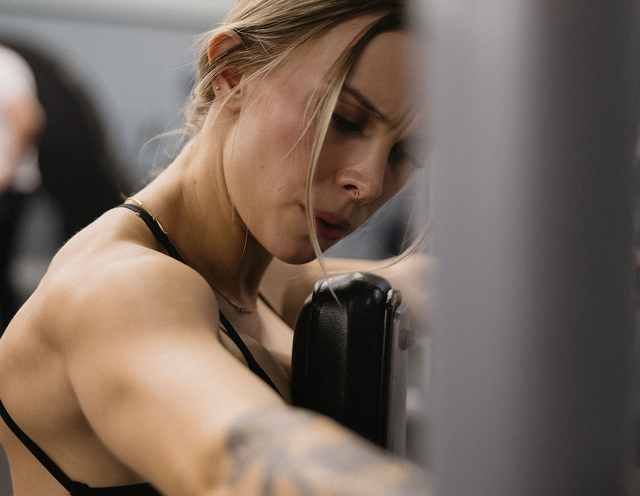Are you ready to take your strength and physique to the next level? Perhaps you've been considering getting into competitive weightlifting but are torn between bodybuilding and strongman. Both sports require immense dedication, discipline, and a commitment to pushing your body to its limits. But what are the key differences between the two, and which path will you choose?
In the world of bodybuilding, the focus is primarily on aesthetics. Bodybuilders train meticulously to sculpt their muscles, striving for the perfect balance of size, symmetry, and definition. It's a sport that demands relentless dedication to strict training regimens and nutrition plans. On the other hand, the sport of strongman is all about raw strength and power. Strongmen compete in a series of events that test their abilities in areas such as deadlifting, log pressing, and atlas stone lifting.
Both bodybuilding and strongman require passion, perseverance, and a deep understanding of the human body. So, which path will you choose? Let's dive deeper into the key differences and explore which sport aligns best with your goals and aspirations.
Understanding Bodybuilding: Focus on Aesthetics and Muscle Definition
Bodybuilding is a sport that revolves around the meticulous development of one's physique, with a strong emphasis on aesthetics. Competitors aim to achieve a balanced physique characterized by size, symmetry, and muscle definition. Unlike other strength training disciplines, bodybuilding prioritizes visual appeal, which means that every muscle group must be proportionately developed. This pursuit of an ideal body shape requires not just physical effort but also a deep understanding of how muscle growth works and how to present it effectively on stage.
The artistry of bodybuilding goes beyond mere muscle size; it involves creating a physique that is visually striking under the scrutiny of judges and spectators. Bodybuilders often spend hours perfecting their poses, ensuring that they showcase their hard work in the best light. This includes understanding how lighting affects muscle definition and learning how to manipulate their bodies to highlight strength and symmetry. Thus, bodybuilding can be seen as both a physical and artistic endeavor, where athletes must combine rigorous training with performance skills.
Moreover, the aesthetic focus of bodybuilding influences training methodologies. Workouts are structured to target specific muscle groups with an aim to sculpt them into the desired form. This often involves high-repetition sets and isolation exercises that promote muscle hypertrophy. As a result, bodybuilders often adopt routines that maximize muscle pump and endurance, which are essential for achieving the coveted look of a well-defined athlete.
The Science Behind Aesthetic Development in Bodybuilding
Muscle hypertrophy, the process of muscle fiber growth in response to resistance training, is the foundation of bodybuilding aesthetics. According to Brad Schoenfeld, Journal of Strength and Conditioning Research, hypertrophy is stimulated by three primary mechanisms: mechanical tension, muscle damage, and metabolic stress. Bodybuilders strategically use training splits and isolation exercises to maximize all three factors, tailoring their routines to enhance specific muscle shapes and lines.
Additionally, posing practice is more than just stage preparation—it also activates muscle fibers in a unique way that may enhance neuromuscular control and muscle detail. Practicing poses regularly helps bodybuilders improve their mind-muscle connection, a critical skill for targeting underdeveloped areas and refining weak points.
Key Principles of Bodybuilding: Training Techniques, Diet, and Supplementation
Targeted Training Techniques for Maximum Muscle Growth
Training for bodybuilding is built upon several key principles that help athletes achieve their goals. One fundamental aspect is progressive overload, which involves gradually increasing the weight or resistance used in workouts to stimulate muscle growth. Bodybuilders often employ techniques such as pyramid training, drop sets, and supersets to challenge their muscles in different ways and prevent plateaus. Each session is meticulously planned, focusing on specific muscle groups to ensure balanced development across the entire body.
Advanced techniques like time under tension (TUT) and rest-pause training are also popular. These strategies extend the duration of muscle strain and improve muscle fiber recruitment, particularly in Type I and Type II fibers, as discussed by Schoenfeld & Grgic, Sports Medicine.
Strategic Nutrition for Muscle Definition and Recovery
Diet plays an equally crucial role in bodybuilding success. Bodybuilders meticulously track their macronutrient intake, ensuring they consume the right balance of proteins, carbohydrates, and fats to support muscle recovery and growth. High-protein diets are particularly favored, as protein provides the building blocks necessary for muscle repair. According to Phillips et al., Applied Physiology, Nutrition, and Metabolism, daily protein intake of 1.6–2.2 g/kg of body weight is ideal for muscle hypertrophy.
Additionally, bodybuilders often cycle their carbohydrate intake around workouts to maximize energy levels and glycogen stores, which are critical for intense training sessions. This strategy, known as nutrient timing, helps optimize both performance and recovery.
Smart Supplementation to Support Training Demands
Supplementation is often used to complement the dietary efforts of bodybuilders. Popular supplements include:
-
Whey Protein – Rapidly absorbed and rich in leucine, a key amino acid for muscle protein synthesis.
-
Branched-Chain Amino Acids (BCAAs) – Help reduce exercise-induced muscle soreness and support endurance.
-
Creatine Monohydrate – Enhances strength and lean body mass; supported by decades of research (Kreider et al., Journal of the International Society of Sports Nutrition).
-
Micronutrients – Vitamins D, C, magnesium, and zinc are especially important for recovery, immunity, and hormone balance.
However, it is essential for athletes to approach supplementation knowledgeably, focusing on high-quality products that align with their individual needs and training goals. Transparency, third-party testing, and research-backed formulations should always be prioritized.
Benefits of Bodybuilding: Improved Physique, Increased Strength, and Self-Confidence
Bodybuilding isn’t just about looks — it comes with a wide range of physical, mental, and emotional benefits that impact everyday life.
Aesthetic Improvements
With consistent training and nutrition, bodybuilders can develop:
-
A well-defined, muscular physique
-
Balanced proportions and symmetry
-
Visible signs of dedication and discipline
This physical transformation often boosts confidence and self-esteem, helping athletes feel more comfortable in their own skin.
Increased Strength and Performance
As training progresses, bodybuilders also gain:
-
Greater muscle strength and endurance
-
Improved performance in everyday tasks and recreational sports
-
A sense of accomplishment that drives continued motivation
Mental Health and Self-Confidence
The discipline needed to follow a strict routine teaches:
Strength training has also been shown to reduce symptoms of depression and anxiety. In a 2018 study by Brett R. Gordon, JAMA Psychiatry, resistance training was linked to moderate improvements in mood and emotional well-being.
Additional Physical Benefits
According to Layne Norton, PhD, BioLayne, hypertrophy training improves:
Understanding Strongman: Focus on Overall Strength and Functional Movements
Strongman is a strength sport built around real-world performance — not appearance. It’s about raw power, movement efficiency, and full-body functionality.
What Makes Strongman Different?
Strongman athletes are tested on:
-
Dynamic strength – flipping tires, carrying yokes, lifting atlas stones
-
Power output – log presses, deadlifts, and overhead events
-
Endurance – performing under time constraints and fatigue
These events mimic real-world tasks and require both strength and agility.
Functional, Full-Body Training
Unlike bodybuilding, strongman workouts focus on:
-
Compound lifts – using multiple muscle groups at once
-
Odd-object training – logs, sandbags, and kegs to build functional power
-
Grip and core strength – critical for carrying and holding heavy implements
As Dr. Jim Stoppani explains, strongman training is highly neurologically demanding and enhances total-body coordination.
Key Principles of Strongman: Training Techniques, Event-Specific Prep, and Nutrition
Event-Specific Training
Every competition is different. Strongman athletes prep by:
-
Practicing actual event movements
-
Repeating lifts like stone loads or log presses
-
Improving technique, speed, and confidence with event-specific drills
Unconventional Strength Building
Strongman uses a mix of tools and strategies:
-
Implements: Logs, stones, tires, sleds, sandbags
-
Planes of movement: Twisting, pulling, pushing, carrying
-
Variety: Keeps training fresh and hits muscles from new angles
Matt Wenning, EliteFTS notes that this variability also reduces injury risk and builds joint stability.
Nutrition for Strength and Performance
Strongman athletes need a lot of fuel to support recovery and energy demands:
-
Calories: Often 4,000–6,000+ per day
-
Macros: Emphasis on protein, complex carbs, and healthy fats
-
Timing: Carbs around workouts and plenty of hydration
Dr. Eric Helms, Mass Research Review recommends strength athletes aim for 1.6–2.2g of protein per kg of body weight, plus strategic carb intake to optimize heavy training sessions.
Benefits of Strongman: Enhanced Strength, Power, and Functional Fitness
Participating in strongman training and competitions delivers more than muscle size — it builds real-world strength, functional ability, and a sense of community.
Raw Strength and Explosive Power
One of the biggest advantages of strongman is the development of total-body strength that transfers beyond the gym. Through high-resistance lifts like:
-
Atlas stones
-
Log presses
-
Tire flips
-
Yoke carries
Strongman athletes gain raw, explosive power that improves performance in sports, labor-intensive work, and everyday life. This type of training develops grip, stability, and the ability to generate force from multiple angles — qualities highly valued across all strength disciplines.
Functional Fitness for Daily Life
Strongman training builds functional fitness, or the ability to perform everyday tasks more easily and safely. Athletes train using:
-
Compound, multi-joint lifts
-
Unconventional objects like sandbags, farmer’s carries, and kegs
-
Rotational and stability-based movements
This style of training improves coordination, balance, and movement efficiency. It also reduces injury risk by reinforcing natural movement patterns. As Dr. Stuart McGill, Backfitpro emphasizes, this kind of loading builds resilient spines and core strength for real-life scenarios.
Community and Camaraderie
Strongman culture is known for its supportive, team-like environment. Competitors often:
This unique camaraderie builds motivation and accountability, especially for newcomers. Competing alongside others who share a passion for strength can be a deeply rewarding experience — and adds an exhilarating element to the sport.
Choosing a Path: Bodybuilding vs. Strongman
Both bodybuilding and strongman offer powerful physical and mental benefits, but choosing the right path depends on your personal goals, preferences, and personality.
Your Fitness Goals
Training Preferences
If you love sculpting your physique, bodybuilding may suit you. If you prefer unconventional training and physical challenge, strongman might be a better fit.
Competition Environment
-
Bodybuilding:
-
Strongman:
-
Performance-based judging
-
Laid-back, supportive vibe
-
Emphasizes lifting ability over appearance
Think about where you feel most comfortable — under stage lights or on the competition field lifting a 300-lb stone.
Training and Competing: Requirements and Challenges in Bodybuilding and Strongman
Bodybuilding: Dedication to Discipline and Aesthetics
To compete in bodybuilding, you’ll need:
-
A long-term commitment to training and nutrition
-
Meticulous macronutrient tracking and meal prepping
-
Skill development in posing and presentation
Bodybuilders often diet for extended periods to reduce body fat, which can be mentally and physically demanding. The preparation for a show may take months and requires consistency, precision, and patience.
Strongman: Strength Development and Event Mastery
Strongman competitors face a different kind of intensity:
-
Training involves lifting awkward, heavy objects
-
Each event requires technique, power, and stamina
-
Athletes must develop grip strength, core control, and explosiveness
Preparation includes loading stones, carrying yokes, pulling sleds, and simulating event conditions to build performance confidence.
Mental Challenges and Growth
Both disciplines also come with mental pressures:
Yet, both offer major psychological rewards: confidence, grit, and a sense of identity built through hard work. These traits often carry into personal and professional life, making both sports deeply transformative.
Conclusion: Embracing Your Chosen Path and Pursuing Your Fitness Goals
Ultimately, the decision between bodybuilding and strongman should be based on your individual goals, preferences, and lifestyle. Both sports offer unique challenges and rewards that can lead to personal growth and achievement. Whether you are drawn to the aesthetic pursuit of bodybuilding or the raw power of strongman, what matters most is that you embrace your chosen path wholeheartedly and commit to your fitness journey.
As you embark on your fitness adventure, remember to set realistic goals and celebrate your progress, no matter how small. The journey in either sport can be long and demanding, but the rewards in terms of improved strength, enhanced self-confidence, and a sense of community are well worth the effort. Surround yourself with supportive individuals who share your passion, and don’t hesitate to seek guidance from experienced trainers or mentors in your chosen field.
Finally, stay open to adapting your goals as you grow and evolve in your fitness journey. Many athletes find joy in exploring different aspects of training, and it is entirely possible to dabble in both bodybuilding and strongman. Regardless of the path you choose, the most important thing is to enjoy the process, challenge yourself, and continue striving for excellence in your physical endeavors.
Need Help With Optimizing Your Nutrition And Training Plan To Finally Get The Results You've Been Waiting For?
The Swole Kitchen is an exclusive membership opportunity for those who are looking to pursue a performance-driven lifestyle. By combining wellness consulting, nutritional lifestyle improvement, and 1:1 customized nutrition plans to our members, our programs aim to optimize human potential. In each of our programs, you’ll receive guidance to reclaim your health, fuel your lifestyle, and pursue performance ambitions, all while learning how to make nutritional decisions from a place of self-trust and intuition. All of our coaches are committed to providing the highest level of results-driven wellness to our members.

SWOLVERINE IS AN ENDURANCE ATHLETE AND ACTIVE LIFESTYLE BRAND. MADE FOR THE ELITE ATHLETE, AND THE STRONG-WILLED OUR PRODUCTS WERE DESIGNED TO FUEL YOUR ATHLETIC PERFORMANCE. WE PERFORM WHEN YOU PERFORM.
We believe that everyone can optimize not only their athletic performance but their human potential. The way we believe we can optimize performance is through transparency, clinically effective doses, and clinically proven ingredients with evidence-based outcomes. We provide the nutrients you need to power your active lifestyle.








